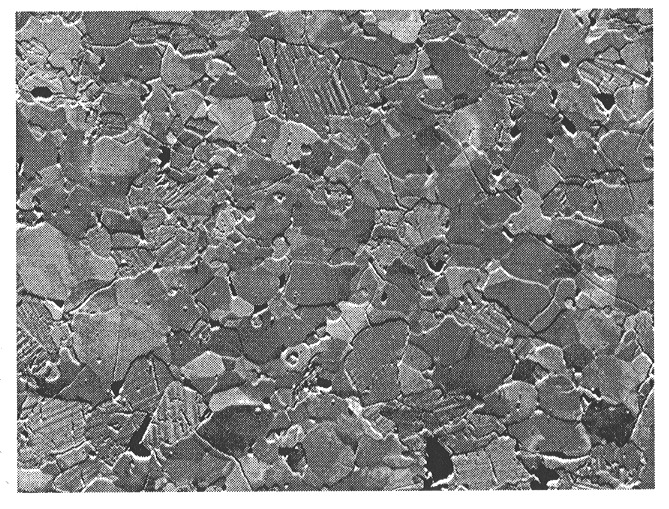

Models describing the rheology of the lithosphere are commonly based on flow laws for single phase materials deforming by dislocation creep mechanisms. However, the strength of the lithosphere is controlled by the mechanical behaviour of polyphase materials; in the upper mantle these rocks are mixtures of olivine and pyroxene ± garnet ± spinel. Neither the microstructural development of polyphase rocks during deformation nor their deformation mechanisms are well understood.
We have used Scanning and Transmission Electron Microscopy (SEM and TEM) techniques to study the microstructure, microtexture (preferred orientations) and microchemistry of an experimentally deformed fine grained (3 - 6 µm) olivine-enstatite mixture. The enstatite has been synthesised from a solid state reaction of San Carlos olivine (Fo90) with quartz. The final mixture contains 75 vol% olivine (Fo90) and 25 vol% enstatite (En92). Deformation has been carried out in creep in a gas-medium apparatus (Paterson rig) at 1200 - 1300°C and a confining pressure of 3 kbar using stress and temperature stepping tests. Deformation conditions during the latter part of the experiments favoured dislocation creep processes; earlier deformation resulted in diffusional creep mechanisms.
Orientation contrast imaging in SEM (Fig. 3.1-5) shows evidence for
grain and interphase boundary migration. Furthermore, since interphase
boundaries are generally directed towards the olivine, i.e. enstatite seems
to 'penetrate' the olivine, enstatite is interpreted to be the phase most
resistant to deformation. Minor cracking occurs within the enstatites,
probably resulting from the transition from proto- to clino-enstatite during
cooling. Planar defect structures in the enstatites are twinning related
(Fig. 3.1-5). Interface population analysis indicates that the two phases
are randomly distributed throughout the sample volume.
 |
Fig. 3.1-5: Orientation contrast image in SEM of an experimentally deformed 25 % enstatite-75 % olivine mixture. Due to the transformation from proto- to clino-enstatite, planar defects developed in the enstatite, enabling the phase identification. Horizontal scale = 200 µm. |
At the TEM scale, all microstructures observed are consistent with the
observed mechanical data, in that the olivine shows mainly a and
c dislocations and subgrain walls. The dislocation microstructures
within the enstatites were destroyed during the transformation from proto-
to clino-enstatite. Grain boundaries between olivine grains tend to be
parallel to low-index planes. Microchemical analyses using the EDX system
attached to the TEM indicate a consistently higher Si content (or a lower
Mg content) at the olivine-olivine grain boundaries when compared to the
bulk (Fig. 3.1-6).
 |
Fig. 3.1-6: Microchemical analysis using the EDX system attached to the TEM across an olivine-olivine grain boundary. The profile shows a higher Si content at the boundary compared to the bulk. The vertical abscissa is atomic % element per atomic % Si |
Time series experiments (i.e. collecting chemical data at one spot in 10
second intervals) show there is no preferential loss of elements with time
(Fig. 3.1-7). Whether this increase in silicon is related to the presence
of enstatite, or reflects the nature of olivine grain boundaries is currently
under investigation.
 |
Fig. 3.1-7: Time series microchemical analysis using the EDX system attached to the TEM (a) within a grain and (b) at an olivine - olivine grain boundary. The analysis shows no preferential loss of the elements with time, neither within the grain nor at the boundary. The vertical abscissa is counts element per counts Si. |

Tel: +49-(0) 921 55 3700 / 3766, Fax: +49-(0) 921 55 3769, E-mail: bayerisches.geoinstitut(at)uni-bayreuth.de
 Previous page
Previous page